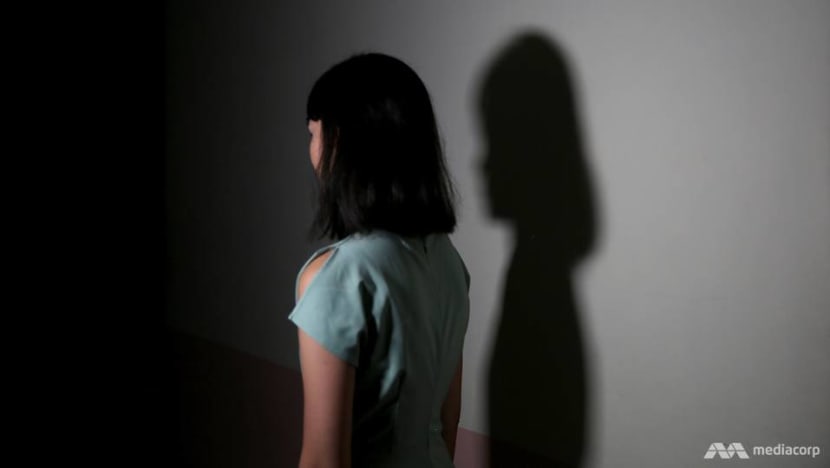commentary Commentary
Commentary: Working together towards a zero-suicide Singapore
A goal of zero suicides seems implausible to achieve, but it’s about challenging myths and making resources accessible, says Nominated Member of Parliament Anthea Ong.

A goal of zero suicides seems implausible to achieve, but it’s about challenging myths and making resources accessible through prioritising suicide prevention (Photo: AFP/STR)
SINGAPORE: Not trying hard enough. Weak. Crazy. Seeking attention. Selfish. Beyond help.
These are common accusations rooted in myths that people with suicidal behaviour have to contend with.
For Lucy (not her real name), having witnessed and lost a friend to suicide, she finds herself struggling with suicide ideation on a daily basis.
It cost me my university education, landed me in tens of thousands of debt, and left me with little means to earn enough to pay back my study loan and survive on my own. I will likely never be able to earn more than S$1000 a month, and will likely take my life than die of other causes in the near future.
Unfortunately, Lucy is not alone in her hopelessness and despair. Alongside 46 other respondents in a public consultation on mental health conducted by my team, their struggles were compounded by stigma and the lack of understanding surrounding suicides in our society.
DISPELLING MYTHS AROUND SUICIDE
In Singapore, it is a common fear that talking about suicide could encourage suicidal behaviour.
Rather than avoiding conversation, it is important that we learn how to talk about suicides responsibly. The expert consensus is to promote resources and reasons for optimism in our conversations, rather than engaging in stigmatising language.
Therefore, if we suspect that a family member or friend may be suicidal, there is no need to give solutions to their problems immediately. Without any judgement, just listen and be with them until the despair and desperation fades, before gently encouraging them to speak with a counsellor or doctor.
READ: Commentary: Isolated with your abuser? Why family violence seems to be on the rise during COVID-19 outbreak
Secondly, suicides do not arise from mental illnesses alone.
According to the WHO, there are social and environmental factors embedded within our society and structures that contribute to an individual’s intention to self-harm or suicide.
In Singapore, intense feelings of hopelessness can also arise from sudden and adverse life events including unemployment, trauma and the loss of loved ones.
I understand this all too well. 13 years ago, I contemplated the possibility of ending it all in the despair caused by a messy divorce, a failed business, and only S$16 in my bank account. Thankfully, I neither attempted nor self-harmed.
It is, therefore, important to understand that suicidal thoughts can be experienced by anyone, not just certain segments of our society.

Thirdly, portrayals of suicides as a selfish decision is inaccurate.
My cousin, who has attempted suicide several times, often shares that he feels that he’s a burden to his family, even as he acknowledged that he knows how much we love him.
While reading a research study on suicide notes in Singapore, a note that brought me to tears was left by a father for his family.
“Father is reluctant to leave all of you. I have failed so badly that I have no choice.”
We need to understand that people who attempt suicide commonly feel that their lives hamper others, viewing their decisions as relieving their loved ones.
Most importantly, it is a myth that those intent on suicide are beyond help.
READ: Commentary: Cabin fever during this COVID-19 outbreak can be overcome
Suicides are preventable. Studies have shown that suicides occurs after much thought and deliberation, which suggests that timely interventions do matter. Moreover, 50 to 60 per cent of suicide victims give some warning of their intentions to a friend or family member.
Struggling with depression, Mark (not his real name) shared with me that unlike his previous counsellors who were dismissive, his current psychologist took the effort to pick up his calls at any hour of the day, especially during the worst of his episodes. He is incredibly grateful to her support.
“She was the one who worked with me until I was able to hold a job, and until I no longer needed sessions with her. She is the one who saved my life.”
THE REALITY OF SUICIDES IN SINGAPORE
Although it is important to dispel myths surrounding suicide, what is more fundamental is for our Government to lead and coordinate efforts in suicide prevention.
I was dismayed to find out that Singapore was one of the few "high income" countries listed without a national suicide prevention strategy by the World Health Organization (WHO). Given the current situation of suicides in our country, I worry that a lack of strategy is costing us dearly.
From 2017 to 2019, there were 1,204 attempted suicides yearly.
READ: Commentary: Will you hire and retain persons with mental health conditions?
Last year, the Immigration and Checkpoints Authority (ICA) reported that there were 8.36 suicides per 100,000 Singapore residents in 2018, up from 7.74 in 2017.
Although our numbers are not high by international standards, the number of deaths by suicides in Singapore has not seen a significant fall from 9.5 suicides per 100,000 residents in the 1980s to 8.3 suicides per 100,000 residents today.

In 2018, teenage suicides were the highest since suicide tracking started in 1991. This is the same for the elderly aged 60 and above who took their own lives. Suicide has also entrenched itself as the leading cause of death for those aged 10 to 29.
"Every life is precious, and each suicide is one too many."
In Parliament last year, Minister for Social and Family Development Desmond Lee made this commitment towards a national response for suicide prevention.
If we are to walk the talk, we need to commit to a zero-suicide Singapore. Through a clear commitment of prioritising and tackling suicide, the Government could make accessible resources for necessary interventions throughout our society.
TOWARDS ZERO SUICIDES
To achieve a zero-suicide Singapore, the Government must start with identifying currently available resources, while committing further resources and funding towards suicide prevention.
One example is to expand funding for organisations like Samaritans of Singapore (SOS), not just to operate our de-facto national suicide helpline, but to ensure timely follow-ups with callers who need further support.
READ: Commentary: Eating disorders are about emotional pain – not food
I am heartened by the Government’s recent assurance that hospitals will track admissions arising from suicide attempts. This should feed into a national strategy of data surveillance coordinated across government agencies and community partners, allowing us to develop informed strategies on suicide prevention.
In schools, many education systems such as the State Government of Victoria in Australia establish step-by-step guidelines on what to do in the event of a suicide attempt. Similarly, the Ministry of Education (MOE) in Singapore should consider laying out their suicide protocols to parents and students clearly and transparently, to help confront increasing suicides amongst our teens.
When developing a national strategy for suicide, it is also important to include the police, the Singapore Civil Defence Force (SCDF), hospitals, our teachers and community support groups, including the SOS, Please Stay Movement, Caring for Life and Oogachaga. Such alignment is necessary, to avoid having a fragmented and sub-optimal approach in suicide prevention.
Above all, we need to remember that all of us play a part in achieving zero suicides. Apart from educating ourselves about suicides, we should be compassionate and empathetic towards those experiencing suicide ideation.
We must work together towards a zero-suicide society that cares because every life matters. And we will not be alone - countries such as the United States, South Korea, Japan and Sweden have already adopted their respective zero-suicide visions.
A zero-suicide Singapore as a goal complements our Vision Zero aspiration for workplace safety, and the Zero Accident movement for our public transportation. This is because when it comes to human lives, such as Lucy’s and Mark’s, nothing short of zero should ever been good enough for us.
Anthea Ong is a Nominated Member of Parliament, a social entrepreneur (Hush TeaBar, A Good Space, WorkWell Leaders Workgroup) and the author of 50 Shades of Love. www.antheaong.com. This commentary is an adaptation of Ms Ong’s speech as part of an adjournment motion in Parliament on Mar 25.














